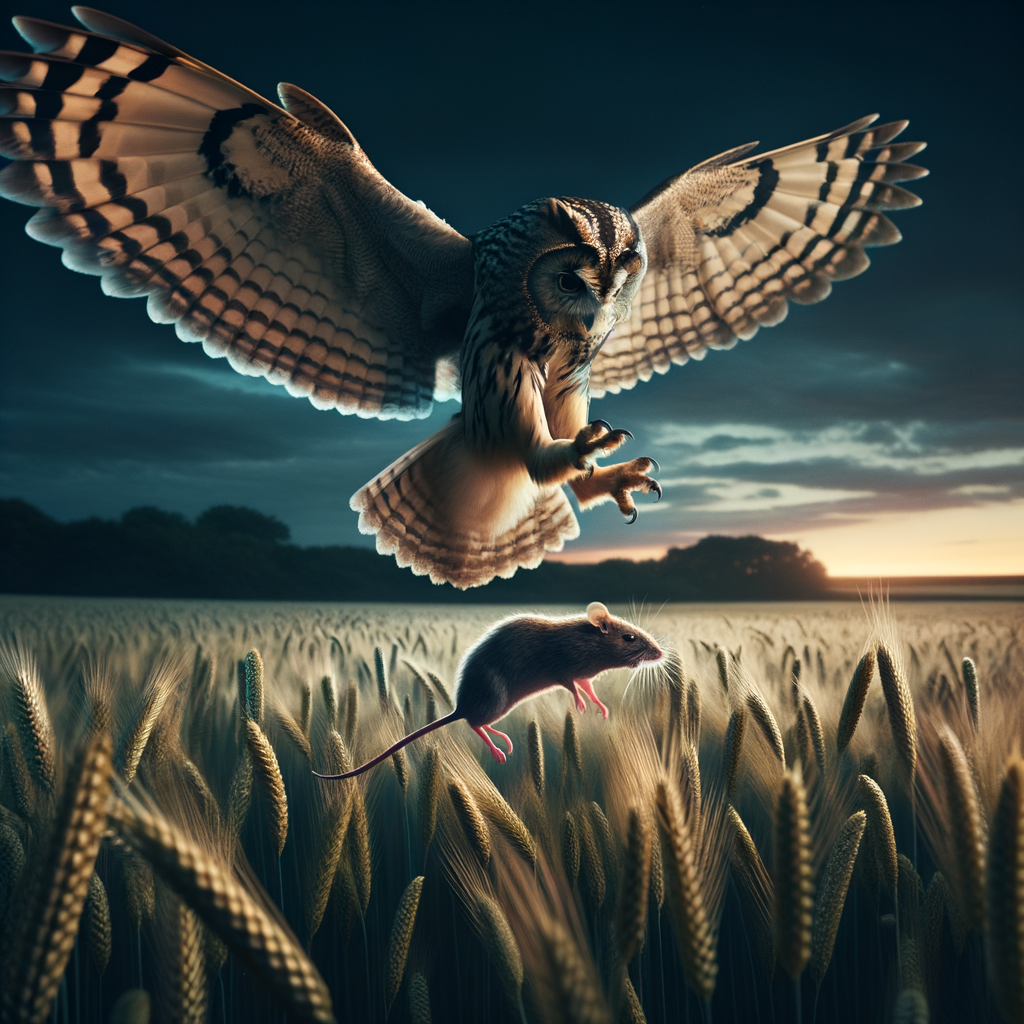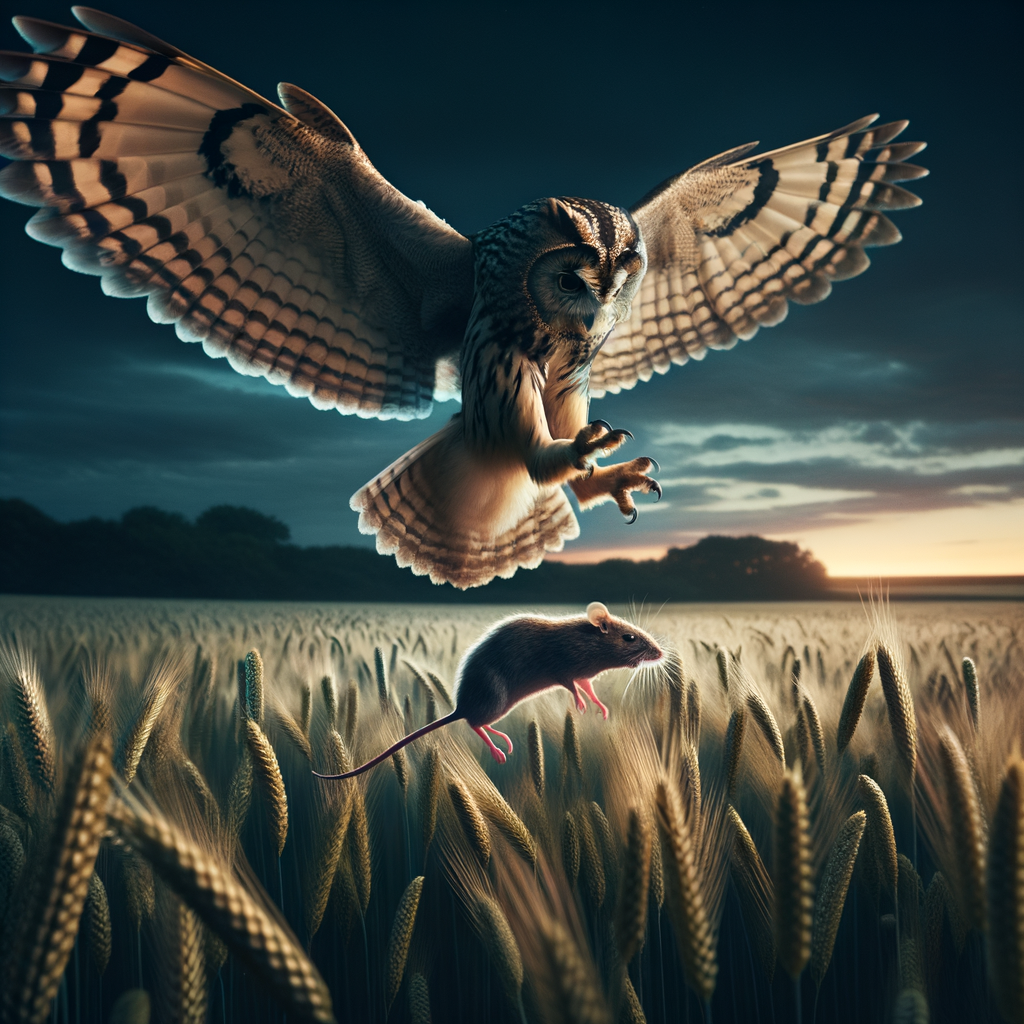
Introduction to Owls: Nature’s Pest Managers
When we think of pest control, we often imagine traps, pesticides, and exterminators. But did you know that nature has its own pest managers? One of the most effective of these are owls. These nocturnal birds of prey play a crucial role in managing pests, particularly rodents, in various ecosystems. Let’s delve into the fascinating world of owls and their role in nature’s pest management.
-
Overview of Owls as Predators
Owls are known for their hunting skills. With their sharp talons and beaks, excellent night vision, and silent flight, they are formidable predators. Owls primarily feed on small mammals, insects, and other birds. The most common prey for many owl species are rodents, including mice, rats, and voles.
Did you know that a single owl can consume up to 1,000 rodents in a year? This makes them one of nature’s most efficient pest controllers. Their hunting activity is not just beneficial for them but also for us humans. By controlling the rodent population, they help prevent the spread of diseases and damage to crops and property.
-
The Role of Owls in the Ecosystem
Owls play a vital role in maintaining the balance of the ecosystem. As top predators, they help control the population of various pests. This is particularly important in agricultural areas where rodents can cause significant damage.
Moreover, owls contribute to biodiversity. Their nests provide homes for other creatures, and their leftover meals (bones and fur they can’t digest and regurgitate as ‘pellets’) provide food for smaller animals and insects.
By understanding the role of owls in the ecosystem, we can appreciate their value and the need to protect their habitats. After all, a healthy owl population means a healthier, more balanced ecosystem.
Owls are more than just mysterious creatures of the night. They are nature’s pest managers, playing a crucial role in controlling pests and maintaining the balance of our ecosystems. So, the next time you hear an owl hooting in the night, remember the important job they’re doing.
Owls in Pest Control
When we think of pest control, we often picture traps, poisons, and exterminators. However, nature has its own pest managers, and one of the most effective are owls. These nocturnal birds of prey play a crucial role in controlling rodent populations.
Understanding the Rodent Control by Owls
Owls, with their sharp talons and keen eyesight, are natural hunters. They are particularly adept at controlling rodent populations. But how do they do it, and what are the benefits of this natural form of pest control?
-
- How owls hunt and control rodent populations
Owls are nocturnal hunters that use their exceptional hearing and sight to locate and catch rodents. They swoop down silently, catching their prey unawares. A single owl can consume up to 1,000 rodents per year, making them a natural form of pest control.
-
- Benefits of natural rodent control
Using owls for rodent control has several benefits. Firstly, it’s a natural and eco-friendly method that doesn’t involve harmful chemicals or traps. Secondly, it helps maintain the balance of the ecosystem by keeping rodent populations in check. Lastly, it’s cost-effective, as owls require no upkeep or resources to do their job.
Owls play a vital role in pest control by naturally managing rodent populations. Their hunting skills, combined with the benefits of natural pest control, make them an invaluable asset to our ecosystem.
Owls as Pest Managers: A Case Study
- Introduction to the case studyOur case study focuses on a small farming community in the Midwest. For years, they struggled with a growing rodent population that was damaging crops and causing significant financial loss. In an effort to control this problem naturally, they introduced a family of owls into the ecosystem.
- Observations and resultsOver the course of a year, the community observed a significant decrease in the rodent population. The owls, being natural predators, controlled the rodent population effectively. The farmers reported less crop damage and a noticeable increase in their harvest.
Month Rodent Population Crop Damage Before Owls High Significant After Owls Low Minimal The table above shows the stark contrast in the rodent population and crop damage before and after the introduction of owls.
- Conclusions and implications for pest controlThe case study concluded that owls can be effective pest managers. By introducing a natural predator into the environment, the community was able to control the rodent population without the use of harmful chemicals. This not only saved the crops but also contributed to a healthier ecosystem.
“The owls have been a game-changer for our community. We’ve seen a decrease in rodents and an increase in our crop yield. It’s a win-win situation for us and the environment.” – Local Farmer
Role of Owls in Rodent Control: Key Takeaways
As we delve into the fascinating world of owls and their role in rodent control, there are some key points we should keep in mind. These takeaways not only highlight the importance of owls in our ecosystem but also shed light on the benefits of natural pest control methods and their implications for human pest control strategies.
-
- Importance of owls in maintaining balance in the ecosystem
Owls play a crucial role in maintaining balance in our ecosystem. They are natural predators of rodents, helping to keep their population in check. Without owls, the rodent population would increase exponentially, leading to a disruption in the food chain and potentially causing damage to crops and property. A study conducted in 2019 found that a single barn owl can consume up to 3,000 rodents in a year, highlighting their importance in rodent control.
-
- Advantages of natural pest control methods
Natural pest control methods, such as the use of owls, offer several advantages over chemical methods. They are sustainable, non-toxic, and do not lead to resistance in pests. Moreover, they help maintain biodiversity by preserving the natural predators in the ecosystem. For instance, owls not only control the rodent population but also serve as prey for larger predators, thus maintaining the balance of nature.
-
- Implications for human pest control strategies
The role of owls in rodent control has significant implications for human pest control strategies. It suggests that instead of relying solely on chemical methods, we should also consider natural methods. Encouraging the presence of owls in rodent-infested areas can be an effective and eco-friendly pest control strategy. This approach aligns with the growing global trend towards sustainable and environmentally friendly practices.
Owls are not just fascinating creatures of the night. They are nature’s pest managers, playing a crucial role in maintaining the balance of our ecosystem. As we continue to explore and understand their role in rodent control, we can learn valuable lessons about sustainable and effective pest control strategies.
Exploring Other Predators in Pest Control
While owls are often celebrated as nature’s pest managers, they are not the only predators that play a crucial role in controlling rodent populations. Let’s explore some of these other predators and understand their hunting strategies, effectiveness, and the role of biodiversity in pest control.
Comparing Owls and Other Predators in Rodent Management
-
- Introduction to other predators
Just like owls, other predators such as snakes, foxes, and cats are also known to keep rodent populations in check. These predators have their unique hunting styles and strategies that make them effective in managing rodents.
-
- Comparing hunting strategies and effectiveness
Owls hunt at night using their exceptional hearing and sight. On the other hand, snakes use their venom and constriction to catch and kill rodents. Foxes use their keen sense of smell and speed, while cats rely on their stealth and agility. All these predators are effective in their own ways, but their effectiveness can vary based on factors such as habitat, availability of prey, and competition from other predators.
| Predator | Hunting Strategy | Effectiveness |
|---|---|---|
| Owls | Night hunting using exceptional hearing and sight | High in areas with ample tree cover |
| Snakes | Use of venom and constriction | High in areas with rocks and crevices |
| Foxes | Use of keen sense of smell and speed | High in open fields and grasslands |
| Cats | Stealth and agility | High in urban and suburban areas |
-
- Understanding the role of biodiversity in pest control
Biodiversity plays a crucial role in pest control. A diverse ecosystem with a variety of predators ensures a balanced and healthy environment. This balance helps keep rodent populations under control, reducing the need for human intervention and the use of harmful pesticides. Therefore, preserving biodiversity is not just important for the survival of different species, but also for effective and natural pest control.
Final Thoughts
As we wrap up our exploration of owls and their role in pest management, it’s clear that these silent night-time warriors play a crucial part in controlling rodent populations. Let’s take a moment to recap what we’ve learned and look ahead to future research and implications.
- Recap of the role of owls in rodent control
Owls, with their keen eyesight, sharp talons, and silent flight, are natural predators of rodents. They help maintain a balance in the ecosystem by keeping rodent populations in check. Studies have shown that a single barn owl can consume up to 1,000 mice per year. This not only aids in pest control but also reduces the spread of diseases that rodents can carry.
- Future research and implications
While the role of owls in rodent control is well-documented, there is still much to learn. Future research could focus on the impact of environmental changes on owl populations and, in turn, rodent populations. Additionally, exploring the potential of owls as a natural alternative to chemical pest control methods could have significant implications for sustainable farming and wildlife conservation.
The Owls are indeed the silent night-time warriors against rodents. They are a testament to nature’s own pest control system, and their role in maintaining ecological balance is invaluable. As we continue to explore and understand these magnificent creatures, we can hope to find more sustainable and eco-friendly pest control solutions.






